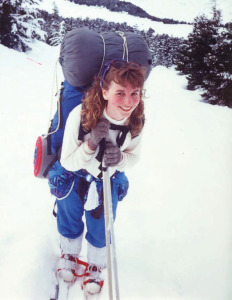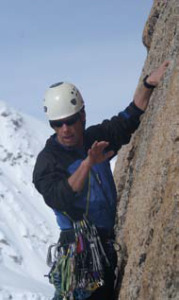With its roots in an outdoor education program begun more than 20 years ago by venerated University ski coach Jim Mahaffey, the Outdoor Studies degree that helps define APU today is a textbook example of capitalizing on strengths.
Mahaffey (see profile Page 24) was offering popular courses at Alaska Methodist University, precursor to APU; his backcountry education trips coincided with increasing national awareness of Alaska as one of the last wild places. In the 1980s and ’90s as APU confronted a dip in enrollment, then-Dean of Students Chipp Leibach initiated an optional firstyear orientation program centered on Alaska wilderness expeditions.
APU called it “Journeys,” and the lure of the Last Frontier worked: the University began attracting more and more students eager for safe, guided, challenging outdoor adventure in Alaska. Leibach also started APU’s extracurricular Outdoor Program. And while Journeys has been broadened so that today it serves as our first-year experience learning community, the Outdoor Program continues to provide gear and organize very affordable trips – helping earn APU a spot as one of Outside Magazine’s Top 25 campuses in 2012.
When Chipp hired me in 1988 to run Student Activities, he valued my experience as an instructor for the National Outdoor Leadership School. But what quickly became apparent is that all the pieces were in place for an academic outdoor recreation program: Our new climbing wall was the talk of the town. An APU-sponsored Sea Kayaking Symposium was a huge success. APU faculty were encouraged to propose a degree and in 1995, newly appointed President Doug North recognized a demand for Alaskabased degrees in Outdoor Studies and Environmental Science. Our large incoming class in 1996 proved North right. Since then, OS has grown to a full-time faculty of five and seen more than 150 students graduate. Our master’s program in Outdoor and Environmental Education—the only one of its kind in Alaska—was added in 2005 and is based at the community service agriculture farm at APU’s Kellogg Campus in semi-rural Palmer.
From its start in the 1980s Superfund era, when Americans were focusing on environmental protection, to its role today as a nationally and internationally ranked leader in outdoor recreation in higher education, APU’s Outdoor Studies program continues to evolve and grow.
In a way, OS is like any “system,” ecological or organizational. I’ve seen OS at APU mature, adapt and become more complex. In the past 20 years, OS faculty have deepened their knowledge and teaching abilities. And while faculty turnover is inevitable, OS at APU has seen remarkable consistency even as relative newcomers Assistant Professor Eeva Latosuo and Associate Professor Michael Kaplan have expanded the degree’s appeal. Eeva contributes a passion for snow science and Mike is helping develop a Children’s Forest in cooperation with the U.S. Forest Service.
At the Kellogg Campus, MSOEE Program Director Steve Rubinstein educates grad students eager to share learning about the environment; Associate Professor David McGivern and his focus on our climbing curriculum turns out some of the most-sought-after guides in Alaska. Our collective success is borne out in OS alumni, many of whom are leaders in outdoor recreation and education, in business and in government.
As program founders recognized a couple of decades ago, Alaska’s position in the world—geographically, socially and historically—helps ensure the future of OS at Alaska Pacific University. OS students and faculty are reminded of our good fortune every time we strap on cross-country skis, settle around a campfire or paddle a glassy bay.
OS students quickly learn that Alaska’s human and natural resources are unequaled. Other than Anchorage, home of APU’s main campus, what other city hosts every national and state land management agency, every major national non-governmental conservation organization? Where else can a student walk out the classroom door and into terrain that presents every major challenge and opportunity that outdoors can offer?
Nowhere but Alaska Pacific University.
Join me in celebrating 20 years of Outdoor Studies at APU. It’s an academic niche as rich and inspiring as Alaska itself.
By Paul Twardock, chair of the Outdoor Studies Department — This article originally appeared in the APU Summit Magazine, Summer 2013.


